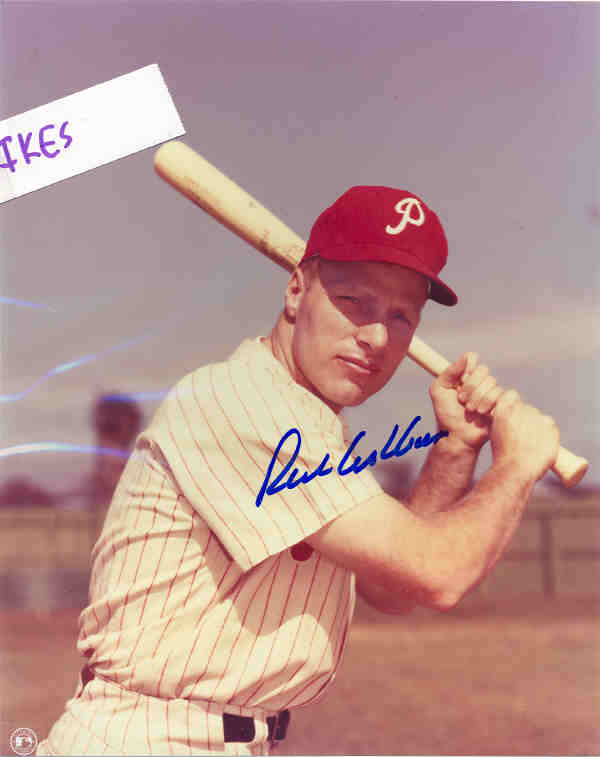Richie Ashburn Philadelphia Phillies Autographed 8x10 Photo HOF COA DECEASED #1
COLOR
~~Great looking autographed photo by former Philadelphia Phillies Hall of Famer...Richie Ashburn.
Richie played for the Philadelphia Phillies 1948-59, Chicago Cubs 1960-61 and New York Mets 1962. During his career, he played in 2189 games and banged out 2574 hits (including 317 doubles, 109 triples and 29 HR's) in 8365 at bats for a .308 career batting average. Richie, whose nickname was the "Cornhusker Express", was named to 5 NL All-Star teams (1948, '51, '53, '58 and '62), led the NL in hits 3x (221 in 1951, 205 in 1953 and 215 in 1958), was a 2x NL Batting Champ (.338 in 1955 and .350 in 1958), was a member of the 1950 NL Champion "Whiz Kids" Philadelphia Phillies team and was inducted into the Baseball Hall of Fame in 1995.
From Wikipedia, the free encyclopedia...
Don Richard "Richie" Ashburn (March 19, 1927 September 9, 1997), also known by the nickname "Whitey" due to his light-blond hair, was an American center fielder in Major League Baseball. He was born in Tilden, Nebraska (some sources give his full middle name as "Richie"). From his youth on a farm, he grew up to become a professional outfielder and veteran broadcaster for the Philadelphia Phillies, and one of the most beloved sports figures in Philadelphia history.
Playing career
One of the famous "Whiz Kids", Ashburn spent 12 of his 15 major-league seasons as the Phillies' center fielder (from 1948 through 1959). He sported a .308 lifetime batting average, led the National League twice in batting average, and routinely led the league in fielding percentage. In 1950, in the last game of the regular season, he threw Dodgers' runner Cal Abrams out at home plate to preserve a 1-1 tie and set the stage for Dick Sisler's home run that clinched the pennant.
Unusual for an outfielder, he was a singles hitter rather than a slugger, accumulating over 2,500 hits in 15 years against only 29 home runs. In his day he was regarded as the archtypical "spray hitter," stroking the ball equally well to all fields, thus making him harder to defend against. Ashburn had the most hits (1,875) of any batter during the 1950s.[1]
During an August 17, 1957 game, Ashburn hit a foul ball into the stands that struck spectator Alice Roth, wife of Philadelphia Bulletin sports editor Earl Roth, breaking her nose. When play resumed, Ashburn fouled off another ball that struck Roth while she was being carried off in a stretcher.
After the 1959 season, Ashburn was traded to the Chicago Cubs for three players, and went on to anchor center field for the North Siders in 1960 and 1961. Anticipating a future career behind a microphone, Ashburn sometimes conducted a post-game baseball instruction clinic at Wrigley Field for the benefit of the youngsters in the WGN-TV viewing audience.
Ashburn was drafted by the expansion New York Mets for the 1962 season. He had a good year offensively, batting .306, and was the team's first-ever All-Star Game representative. However it was a frustrating year for the polished professional, who had begun his career with a winner and found himself playing for the losingest team in baseball history (with a record of 40-120). He retired at the end of the season.
One oft-told story is that on short flies to center or left-center, center fielder Ashburn would collide with shortstop Elio Chacón. Chacón, from Venezuela, spoke little English and had difficulty understanding when Ashburn was calling him off the ball. To remedy matters, someone in the Mets organization taught Ashburn to say "Yo la tengo," Spanish for "Ive got it." When Ashburn first used this phrase, it worked fine in keeping Chacón from running into him. But then left fielder Frank Thomas, who didn't speak a word of Spanish, slammed into Ashburn. After getting up, Thomas asked Ashburn "What the heck is a Yellow Tango?"
In his last five seasons, Ashburn had played for the 8th-place Phillies, the 7th-place Cubs and the 10th place Mets. The infamous first-year Mets club won only a quarter of its games, and Ashburn decided to retire from active play. The last straw might have been during the Mets' 120th loss, when Ashburn was one of the three Mets victims in a triple play pulled off by his former teammates the 9th-place Cubs.
Post-career
Starting in 1963, Ashburn became a radio and TV color commentator for his original big-league team, the Phillies. He first worked with long-time Phillies announcer By Saam. In 1971, Harry Kalas joined the team. Ashburn worked with these two future winners of the Ford C. Frick Award for the next few years. Saam retired in 1976, and Ashburn continued working with Kalas for the next two decades, the two becoming best friends. Ashburn also regularly wrote for The Philadelphia Bulletin and, later, The Philadelphia Daily News.
Ashburn was elected to the Baseball Hall of Fame by the Hall's Veterans Committee in 1995. Phillies great Mike Schmidt was inducted in the same ceremony. Over 25,000 fans, mostly from Philadelphia, traveled to Cooperstown for the ceremony.
According to his mother, Ashburn planned on retiring from broadcasting at the end of the 1997 season. He died of a heart attack in New York City at age 70, after broadcasting a Phillies-Mets game at Shea Stadium. A large crowd of fans paid tribute to him, passing by his coffin in Philadelphia's Fairmount Park. He is interred in the Gladwyne Methodist Church Cemetery, at Gladwyne, Pennsylvania.
The center-field entertainment area at the Phillies current stadium, Citizens Bank Park, is named Ashburn Alley in his honor, in response to the demand of numerous fans requesting that the Phillies name that stadium in Ashburn's honor due to his nearly half-century of service to the team.
Lifetime guarantee in regards to this autographed photo which also comes with a COA from Gearhart Enterprises, Inc. Member of the UACC. UACC Registered Dealer #RD189.
